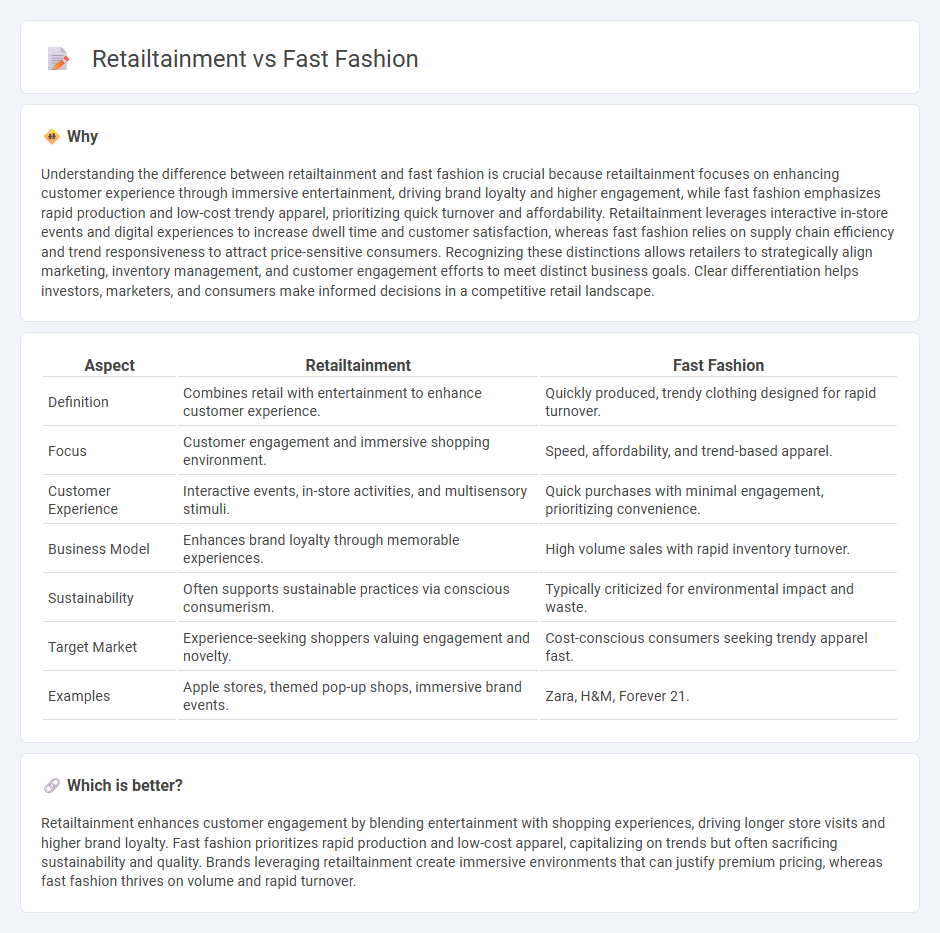
Retailtainment blends interactive experiences and entertainment within retail spaces to boost customer engagement and brand loyalty, contrasting sharply with fast fashion's focus on rapid production cycles and trend-driven, low-cost apparel. Retailtainment enhances in-store visits by integrating technology and immersive activities, while fast fashion prioritizes quick turnover and affordability to attract price-sensitive shoppers. Explore how these two retail strategies are reshaping consumer behavior and industry dynamics.
Why it is important
Understanding the difference between retailtainment and fast fashion is crucial because retailtainment focuses on enhancing customer experience through immersive entertainment, driving brand loyalty and higher engagement, while fast fashion emphasizes rapid production and low-cost trendy apparel, prioritizing quick turnover and affordability. Retailtainment leverages interactive in-store events and digital experiences to increase dwell time and customer satisfaction, whereas fast fashion relies on supply chain efficiency and trend responsiveness to attract price-sensitive consumers. Recognizing these distinctions allows retailers to strategically align marketing, inventory management, and customer engagement efforts to meet distinct business goals. Clear differentiation helps investors, marketers, and consumers make informed decisions in a competitive retail landscape.
Comparison Table
| Aspect | Retailtainment | Fast Fashion |
|---|---|---|
| Definition | Combines retail with entertainment to enhance customer experience. | Quickly produced, trendy clothing designed for rapid turnover. |
| Focus | Customer engagement and immersive shopping environment. | Speed, affordability, and trend-based apparel. |
| Customer Experience | Interactive events, in-store activities, and multisensory stimuli. | Quick purchases with minimal engagement, prioritizing convenience. |
| Business Model | Enhances brand loyalty through memorable experiences. | High volume sales with rapid inventory turnover. |
| Sustainability | Often supports sustainable practices via conscious consumerism. | Typically criticized for environmental impact and waste. |
| Target Market | Experience-seeking shoppers valuing engagement and novelty. | Cost-conscious consumers seeking trendy apparel fast. |
| Examples | Apple stores, themed pop-up shops, immersive brand events. | Zara, H&M, Forever 21. |
Which is better?
Retailtainment enhances customer engagement by blending entertainment with shopping experiences, driving longer store visits and higher brand loyalty. Fast fashion prioritizes rapid production and low-cost apparel, capitalizing on trends but often sacrificing sustainability and quality. Brands leveraging retailtainment create immersive environments that can justify premium pricing, whereas fast fashion thrives on volume and rapid turnover.
Connection
Retailtainment enhances consumer engagement by blending entertainment elements with shopping experiences, which fast fashion brands leverage to attract younger, trend-driven audiences. Fast fashion retailers incorporate interactive displays, social media integration, and immersive events to create a dynamic environment that encourages impulse purchases and brand loyalty. This fusion of retailtainment with fast fashion strategies drives increased foot traffic and accelerates inventory turnover through emotionally charged, experience-based shopping.
Key Terms
Speed-to-Market
Fast fashion thrives on an exceptionally rapid speed-to-market, producing trend-driven apparel within weeks to meet immediate consumer demand. Retailtainment, on the other hand, integrates experiential elements in-store but often sacrifices some speed for enhanced customer engagement and brand storytelling. Explore how balancing speed-to-market with immersive experiences shapes future retail strategies.
Experiential Shopping
Fast fashion emphasizes rapid turnover of trendy, low-cost apparel, prioritizing convenience and affordability for consumers. Retailtainment blends retail and entertainment to create immersive, sensory-rich in-store experiences that boost engagement and brand loyalty. Discover how experiential shopping is transforming consumer behavior and retail strategies by exploring the latest trends in retailtainment.
Inventory Turnover
Fast fashion brands typically achieve high inventory turnover rates by rapidly producing trendy, low-cost items that respond quickly to consumer demand, minimizing stock obsolescence. Retailtainment, combining retail and entertainment experiences, focuses on creating immersive shopping environments that encourage longer store visits but may result in slower inventory turnover due to higher engagement and customized product offerings. Explore how these distinct strategies impact sales velocity and supply chain efficiency in the dynamic retail landscape.
Source and External Links
Fast fashion - Wikipedia - Fast fashion is a business model that quickly replicates current catwalk trends and produces them inexpensively for mainstream consumers, emphasizing rapid turnover and low-cost production to offer new styles frequently, exemplified by brands like Zara and H&M.
Fast fashion disaster | WWF - Fast fashion produces cheap, low-quality clothing rapidly and in large quantities, driving overconsumption and causing serious social issues such as poor labor conditions and exploitation in garment factories worldwide, especially in countries like Bangladesh and India.
Fast fashion | History, Definition, Brands, Companies, ... - Britannica - Emerging in the 1970s and expanding in the 1990s, fast fashion has significant environmental impacts including high carbon emissions, massive water use, chemical pollution, textile waste, and reliance on non-biodegradable synthetic fibers, resulting in extensive landfill accumulation and environmental degradation.
 dowidth.com
dowidth.com